Experience Americas Most Treasured Roads
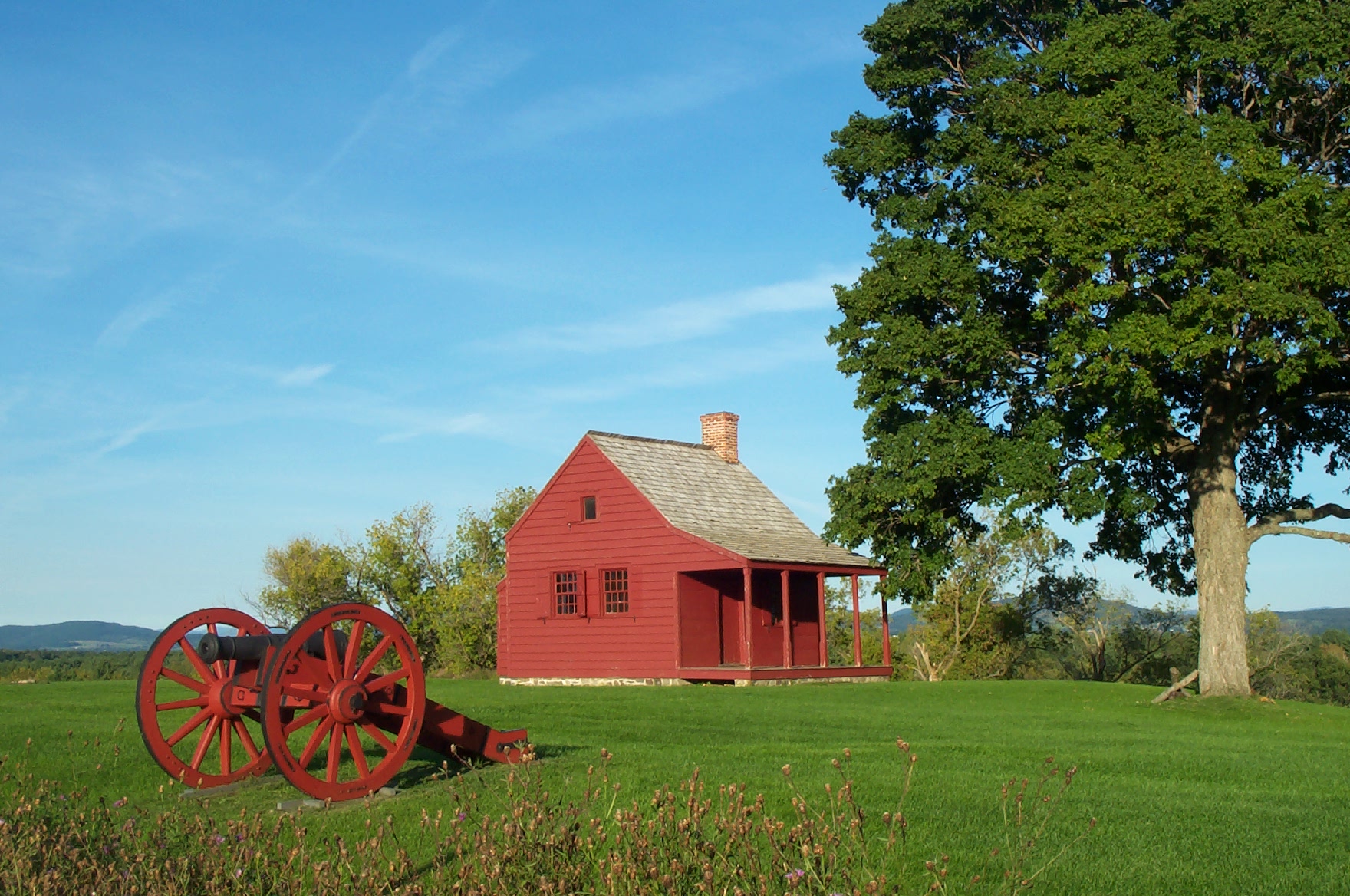
Full Video Tour: Mohawk Towpath
DAY ONE
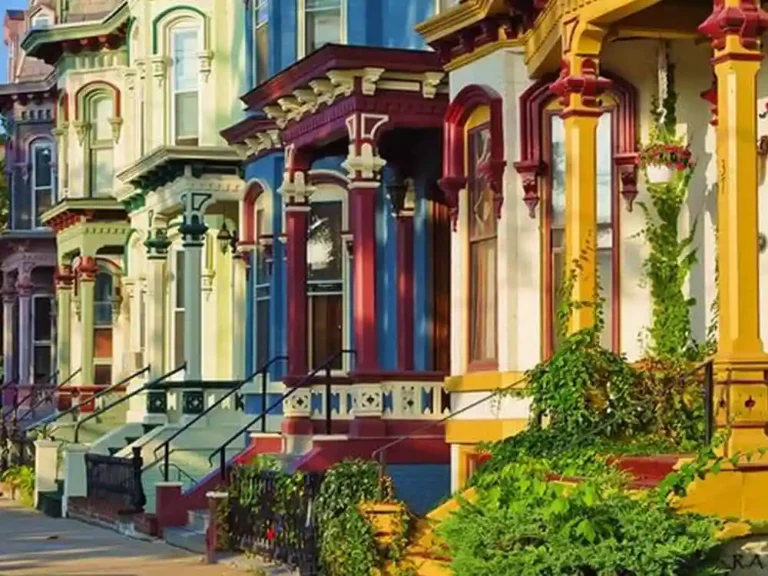
Saratoga Springs
It was 1802 when Gideon Putnam arrived on horseback to carve a frontier resort town he was sure would attract tourists. Starting with a three story tavern near Congress Spring, he laid out Broad Street at the center of town and soon residences and businesses began popping up to welcome visitors arriving by horse and buggy. A racing meet for thoroughbreds in 1863 created the Saratoga Race Course, the oldest race in America. In 1876, Frederick Olmsted, designer of New York’s Central Park arrived to lay out Congress Park to celebrate the mineral springs in a beautiful setting.
Saratoga Springs Heritage Area Visitor Center
Designed to be a “gateway” to the city, the Visitor Center was built in 1915 as a trolley station for the Hudson Valley Railway Company. Two bas-relief murals depict the legend of Sir William Johnson being brought to the High Rock Spring and the surrender of British General John Burgoyne to American forces under General Horatio Gates at the Battle of Saratoga. A short video presentation introduces you to more of this history.
297 Broadway, Saratoga Springs, NY 12866, 518-587-3241
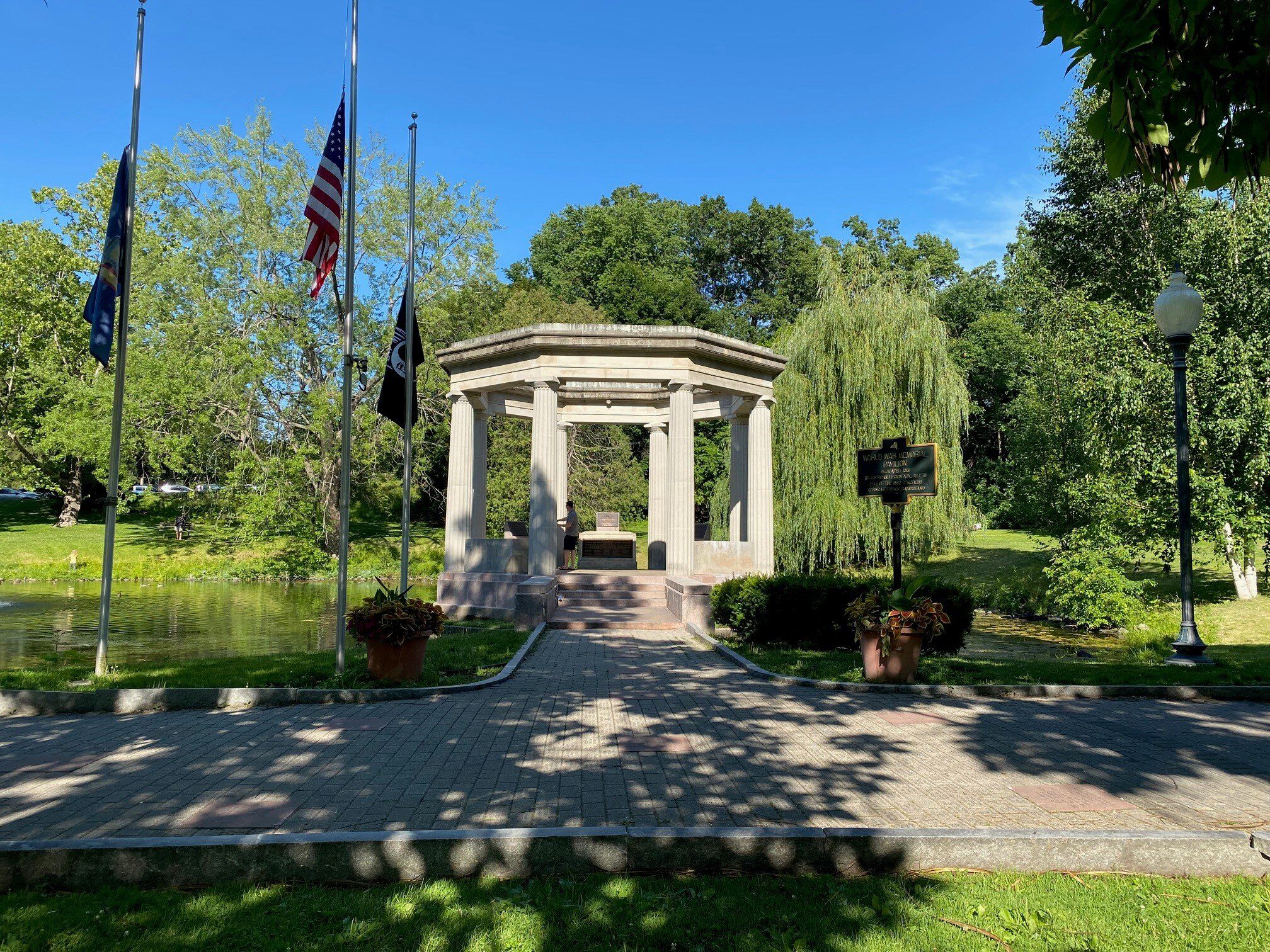
Walking Tours of Saratoga Springs
Enjoy one or all of five walking tours of Saratoga Springs: Historic Congress Park, the East Side and West Side Residential Walking Tours, North Broadway, and a tour of the other Mineral Waters in the city.
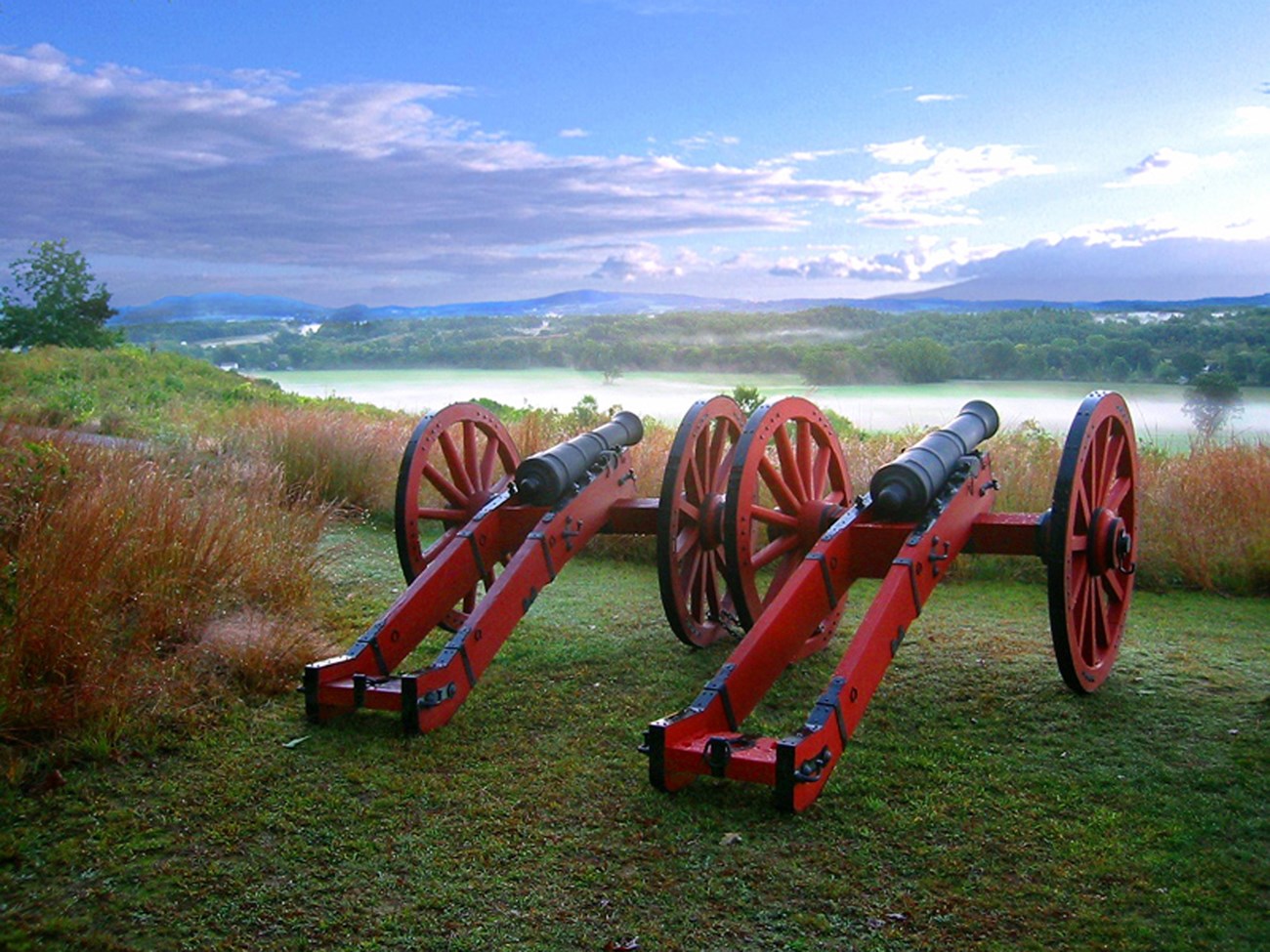
Saratoga National Historical Park
In the fall of 1777 American forces gained a crucial victory, the first surrender of the British Army during the Revolutionary War. It renewed the patriots’ hopes for independence, secured essential foreign recognition and support, and forever changed the world. Tour the Neilson House, the sole surviving structure that witnessed the Battle of Saratoga, Schuyler House, built in 1777 right after the British burned the second house, the Saratoga Surrender Site, Victory Woods, and the Wilkerson Trail, the same path soldiers marched to battle.
648 Route 32, Stillwater NY 12170, 518-670-2985
Saratoga Springs History Museum
The History Museum preserves 15,000 objects ranging from the 1802 Gideon Putnam Tavern sign to Victorian dresses, ephemera from the mineral springs, and beyond. The George S. Bolster Collection is a nationally recognized visual record of over 325,000 photographic negatives of Saratoga Springs from 1855-1980. In the Walworth Memorial Museum on the third floor, seven rooms relate the tragic story of the Chancellor Reuben Hyde Walworth family with unhappy marriages, early death, and a grandson murdering his father, one of Rueben’s sons. In the 1870 Casino’s large gambling room, also known as Morrissey’s Club House, men could play faro, roulette, rouge-et-noir, and Boston. Women and locals were not admitted. When Richard Canfield bought the property from the Morrissey estate, he added the Italian Gardens, the magnificent dining room with stained-glass in the vaulted ceiling, and the High Stakes Room where bets running into the hundreds of thousands of dollars were placed.
One East Congress Street, Saratoga Springs, NY 12866, 518-584-6920 Adults $10
Saratoga Spa State Park
The appeal of the healing waters of “The Queen of Spas” was so profound they had to be protected when more than 200 companies began distributing the water. New York State declared it a State Park in 1962 and a National Historic Landmark in 1987. Today, renowned for classical architecture and mineral springs, it is open year-round to “take the waters.”
Weekends May 1-30, 8:30AM-4:30PM, Daily May 30-Sept 7, 8:30AM-4:30PM, Weekends and Holidays Sept 7-Oct 11, 8:30AM-4:30PM $10 per vehicle. Additional fee for Victoria Pool.
19 Roosevelt Drive, Saratoga Springs, NY 12866, 518-584-2535
Beekman Street Arts District
Three blocks of the turn-of-the-century working class homes that line Beekman Street are filled with art galleries, restaurants, and shops.
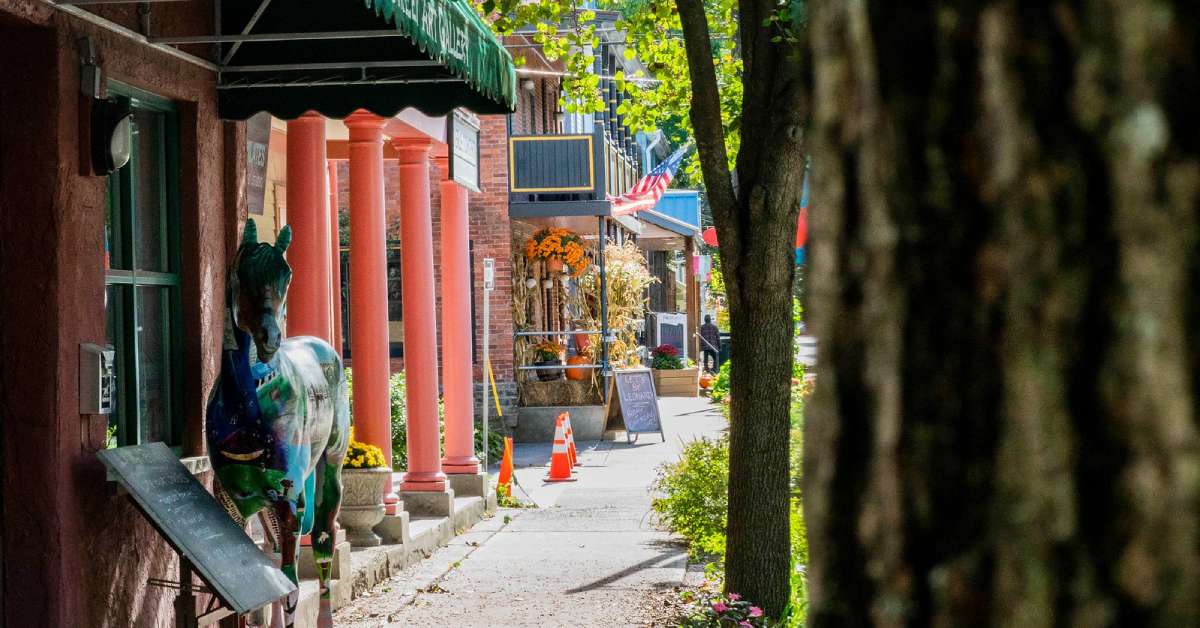
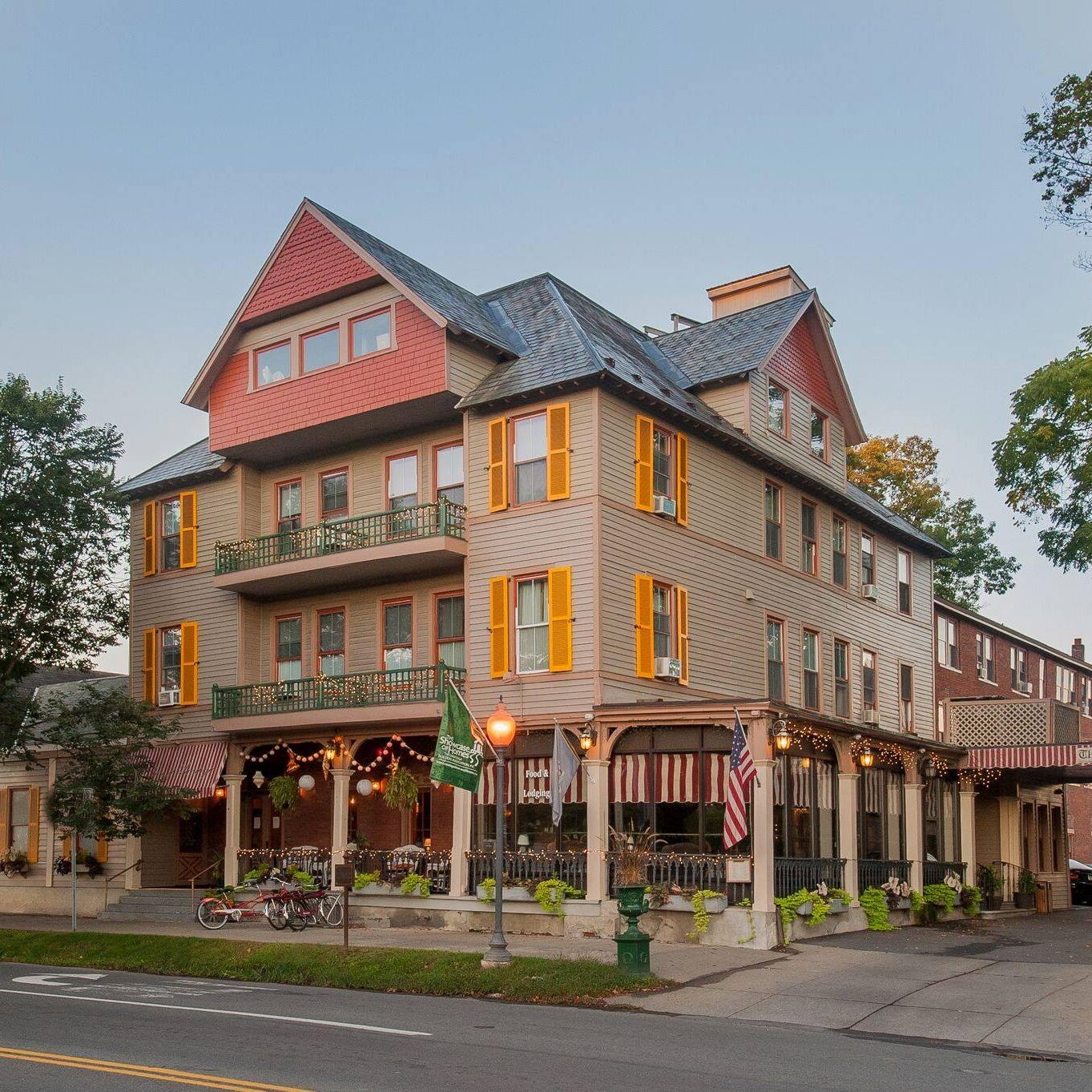
Destination Distinctive Accommodations
The Inn at Saratoga, 231 Broadway, Saratoga Springs, NY 12866, 518-583-1890 The 1843 Inn at Saratoga was a boarding house for chronically ill patients, a high-class hotel for Cuban vacationers, and a Jewish hotel before it was transformed into today’s inn. The high Gothic Victorian façade was added in 1862. Choose from the 42 unique guest rooms, each with hand-crafted mahogany furniture, four poster beds and carefully chosen antiques, complemented with Wi-Fi, pillow top bedding, flat screen TVs, and mini-fridges.
Destination Distinctive Dining
15 Church Restaurant, 15 Church Street, Saratoga Springs, NY 12866, 518-587-1515 Fine dining at its best in Saratoga Springs.
Osteria Danny, 26 Henry Street, Saratoga Springs, NY 12866, 518-423-7022 Unique combinations, flavors and a wide ranging menu.
Scallions, 44 Lake Avenue, Saratoga Springs, NY 12866, 518-584-0192 Sandwiches, vegan, vegetarian, café style.
DAY TWO
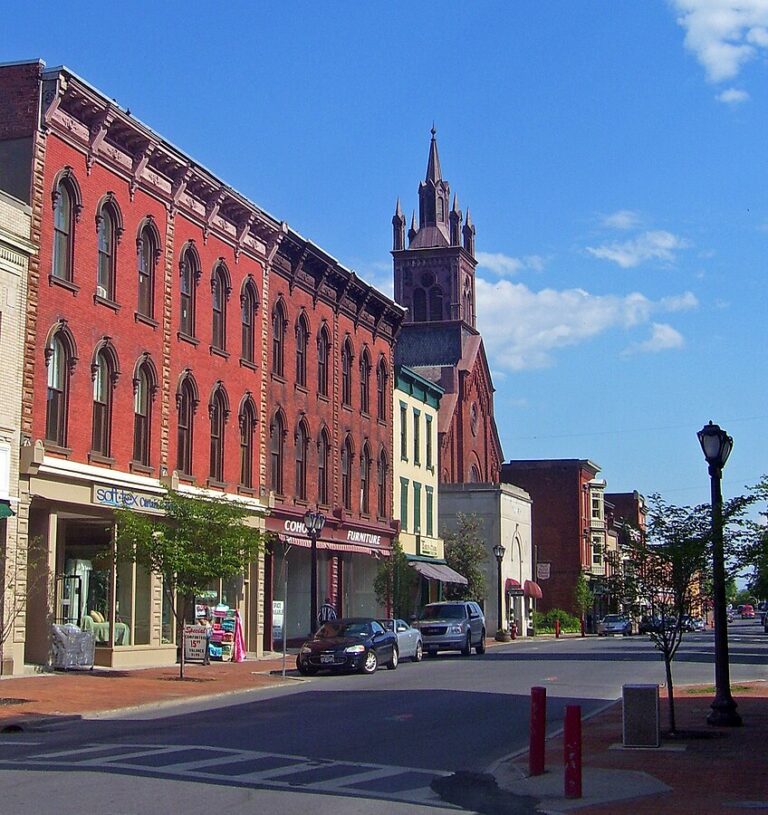
Cohoes
One of the earliest towns in the region, Cohoes was built on land bought by the Dutch West India Company from local Native Americans in 1630. Inexpensive waterpower brought in manufacturing, powering growth from 150 residents in 1840 to 4,229 in 1850. By 1870, the town had grown to 15,357, who worked at six large cotton mills running 203,000 spindles, eighteen knitting mills, two foundries, and three machine shops.
Riverspark Cohoes Visitor Center
Housed on the first floor of the historic Cohoes Music Hall, the visitor center features the “A Day in the Life of Cohoes: 1882”, complemented by exhibits including Cohoes Falls – A Short Story which recaps Cohoes Falls’ history from 20,000 BCE to the present, the Harmony Mill Power System, which shows how the Boydon turbines that supplied power to the machinery worked, Mill Work Audio Stories, 4-5 minute interviews with actual mill workers recorded in the 1970s, Lock 38, which shows how a canal boat moved through a lock, and the Canal Lock Experience, a hands on demonstration with four lock chambers.
58 Remsen Street, Cohoes, NY 12047, 518-237-0078
Waterford
Originally named Halfmoon after Henry Hudson’s ship, which was likely stopped by the “riffs” at North Waterford, Waterford is the oldest incorporated village in New York State. Local history from the Early Dutch Period is carefully preserved in the quaint, colonial village with narrow, tree lined streets.
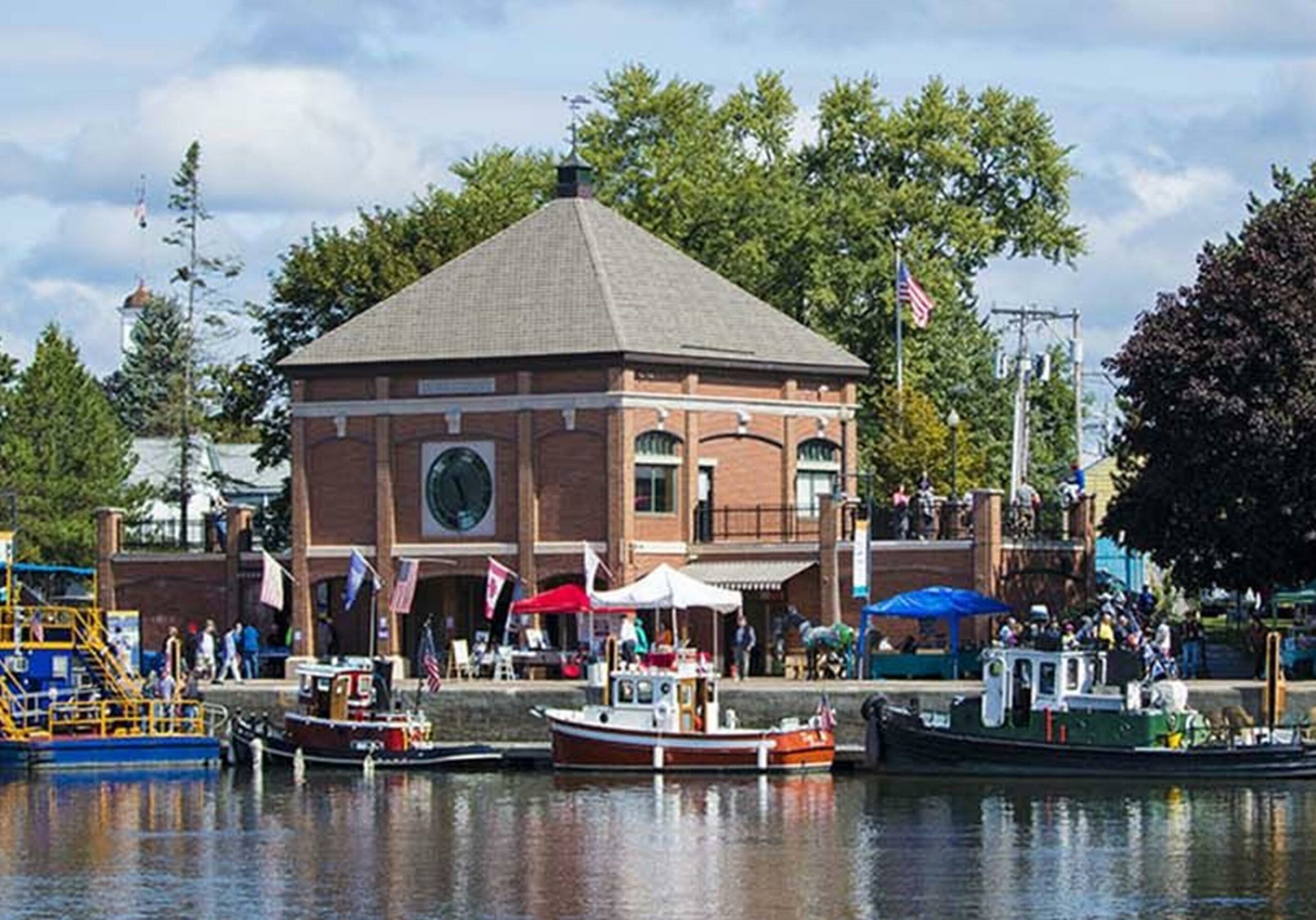
Waterford Historical Museum and Cultural Center
When the beautiful 1830 Federal residence that now houses historic exhibits was scheduled for demolition, the Historical Society had it moved and transformed into a museum that parallels the history of the town with the story of the original owner. Hugh White, who owned a sawmill, flour mill, and cement works, served as Bank of Waterford President, a church trustee, and even three terms in the US Congress.
Champlain Canal Lock 4
Located at the bottom of the hill from the Waterford Museum, the Champlain Canal Lock 4 was rebuilt three times between 1822 and 1870, the first two wooden and the third, stone. Guard locks were used to keep high water out of the canal. If the river was normal, the lock doors were open so boats could enter. If the water was high, the lock doors closed, and boats had to go through the lock in order to get into the canal. It is accessible by the staircase to the far right of the museum parking lot.
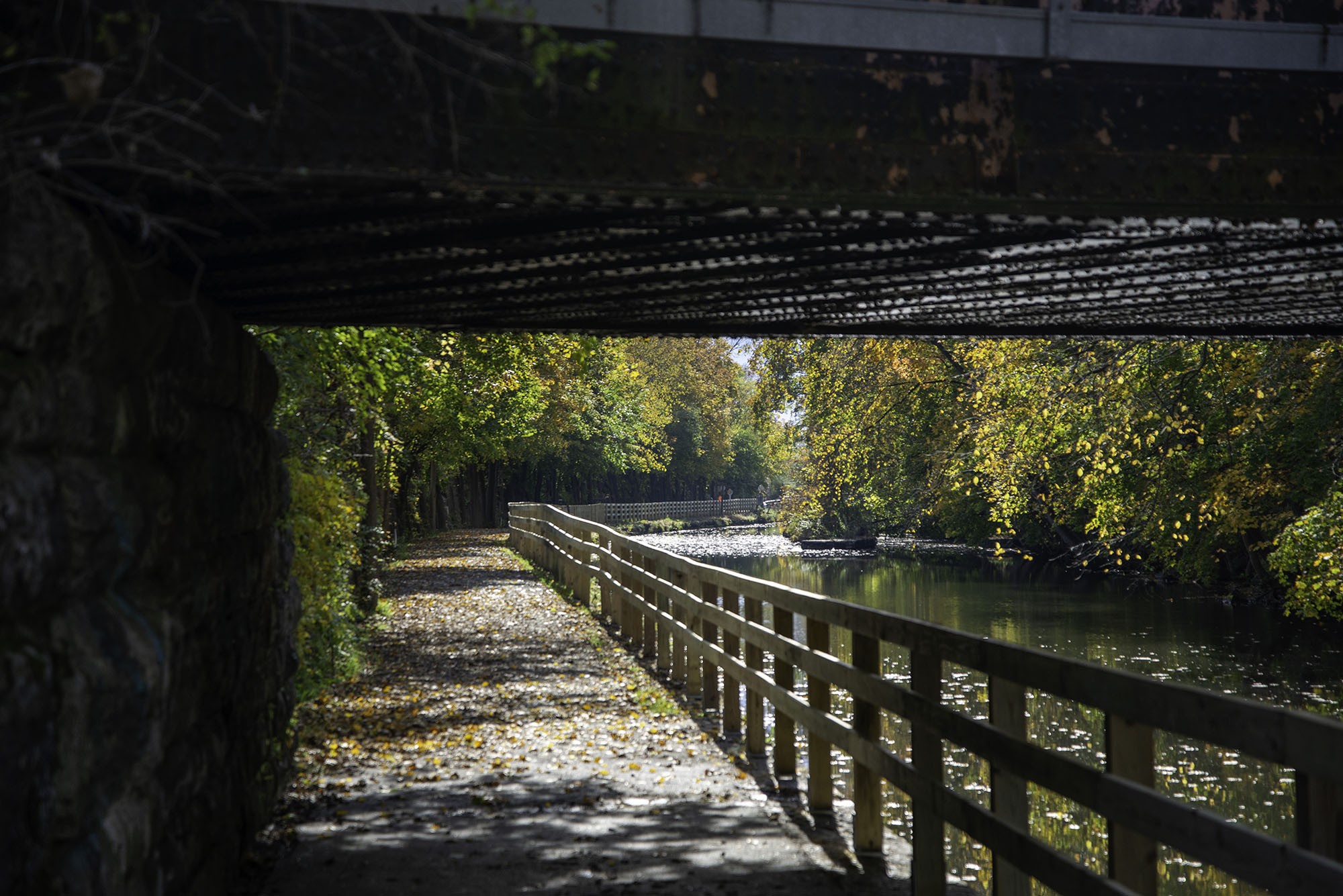
Champlain Canalway Trail
The Champlain Canalway Trail in Waterford which begins at the Old Champlain Lock, continues about 1.25 miles to the 4th Street Bridge and the Erie Canal Lock 2 Park for another third of a mile, and another 1.9 north to the border with Halfmoon. Signs point the way through town.
Walking Tour of Waterford
The tour encompasses 29 stops featuring structures that were standing in the canal era, including the 1799 Dutch Reformed Parsonage, 1826 Issac Eddy Homestead, 1828 George Washington Eddy House, 1842 Saratoga National Bank, 1840 Beslin Ormsby House, 1770 45-47 Second Street, 1867 Knickerbocker Steamer Company (the fire company), 1841 Classic Hall, 1802 General Samuel Stewart House, and the 1835 D&H Building.
The tour begins at 20 Third Street.
Erie Canal Lock 2 Park
This is your first chance to see a lock on the New York State Barge Canal in operation. In addition, the park includes Side Cut Locks, today used as a spillway for excess water flowing into the Hudson River when Lock 2 is in operation. This area is also referred to as “The Crossroads” where, historically, a boat entering the top chamber of the lock and turning right headed north to Lake Champlain, and a left turn took the boat to Albany. The 1823 Chaplain Canal Basin is adjacent to the park.
Destination Distinctive Dining
McGreivey’s, 91 Broad Street, Waterford, NY 12188, 518-238-2020
The original Irish pub and restaurant in Waterford.
Flight of Locks
A short drive from downtown takes you to the beautiful park that surrounds the Waterford Flight Locks E-2 through E-6 which lift vessels 169 feet from the Hudson River to the Mohawk River to bypass Cohoes Falls. These five large locks replaced the original 16 locks it took to get through Cohoes on the original canal system. The panoramic views from the park are impressive.
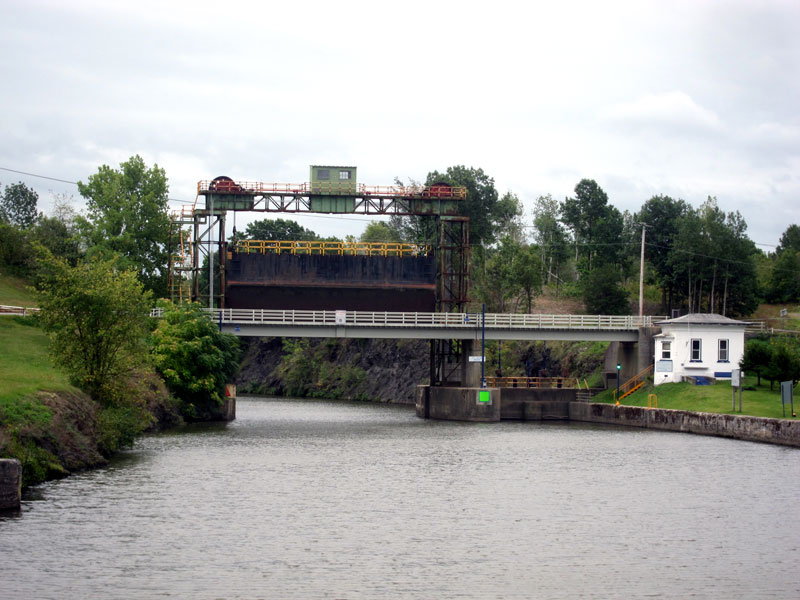
Waterford Harbor Visitor Center
Learn the story of the region starting with the first farmers in 1668, the Revolutionary War in 1777, river trade starting in Waterford in 1799, the completion of the Erie and Champlain Canals in the 1820s, and the construction of the Waterford Flight of Locks in 1915. Located between Peebles Island and the Village, this is the northernmost point where the water of the Mohawk and the Hudson converge.
1 Tugboat Alley, Waterford, NY 12188, 518-233-9123
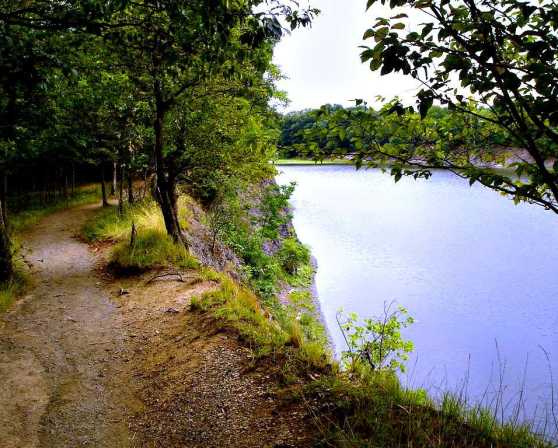
Peebles Island State Park
In case the American forces were overwhelmed at the Battle of Saratoga, Peebles Island and Van Schaick Island were prepared for battle with earthworks protecting three batteries of cannons, 5,000 troops and entrenchments for troop movements, to keep the British from capturing Albany. Take the two-mile perimeter walking trail with great views of Cohoes Falls and the Mohawk River.
Van Schaick Island
The main draws here are the Matton Shipyard and the Van Schaick House which served as the planning site for the Battle of Saratoga. Constructed in 1735 on property that was part of the Halve Mann patent, it also served as the New York State Capitol for a few days in 1777. The Matton Shipyard moved to the island in 1916 and continued to build and service boats for navigation on the Barge Canal until 1983. Within four years during World War II, the yard produced 5 submarine chasers and four tugs. The eight extant buildings include the offices, carpenter shop, and garage, dating from 1916, and several others built in 1936. Today, the shipyard is being turned into an educational center, museum, and anchor for historic vessels.
One Delaware Avenue North, Cohoes, NY 12047, 518-268-2188
Harmony Mills Historic District
The Harmony Mills Historic District encompasses a series of 19th century brick mill buildings and worker housing just below Cohoes Falls. When completed in 1872, Harmony Mill 3 was the largest individual cotton factory in the world. A complete skeleton of a prehistoric mastodon was discovered during construction. The first mill erected in 1837, burned in 1998. Mill 2 burned in 1995. Mill 3 and Mill 4 have been transformed into high-end residential lofts, which received the New York State Preservation League Excellence Award and hailed as a prime example of how adaptive re-use of historic buildings can revitalize cities.
Falls View Park – Cohoes Falls
The Mohawk River drops 90 feet over Cohoes (Native American for falling canoe) Falls which made it an impediment to a water route through the Appalachians, creating the need for the first lock system to span the gap. Enjoy spectacular views during high water, the most exciting time to experience the thundering falls. Open May 1– Nov 1, dawn until dusk.
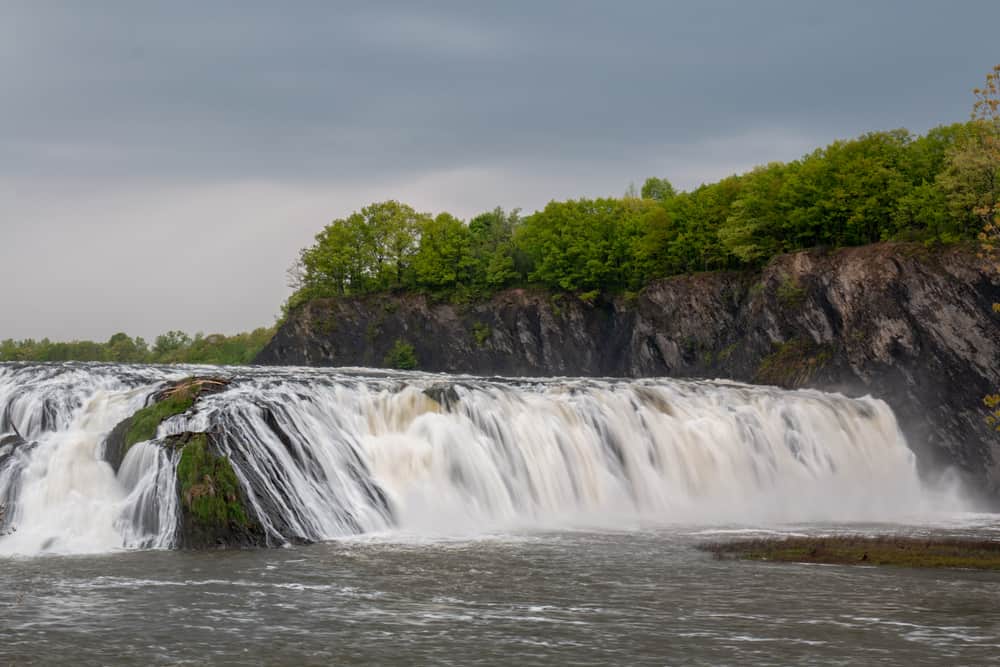
Old Military Crossing Historical Marker
This ford across the river was used for an attack on Fort Ticonderoga during the French and Indian War, and held by Generals Enoch Poor and Benedict Arnold in the American Revolution. The actual fording location is now covered by the footprint of the NY Power Authority dam and powerhouse.
Freddie’s Park
At this location on the Erie Canal, an aqueduct was constructed to carry the canal, water, and towpath across to the North side of the river. Freddie’s Park is the southern end of the longest aqueduct on the canal, with the northern end in Crescent. Look toward the brick Federal style building to visualize the 26 arched piers which spanned 1,160 feet, the longest structure of its kind in the world at the time.
Crescent Park
Founded in 1791, Crescent developed into an important colonial shipping point for ice, grain, hay, bricks and molders’ sand, and supply point for “canawlers.” Alfred Noxon established an iron works, paint shop, hotel, and commercial block that employed between 75 and 100 men and built the imposing brick and stone Farmers Bank of Saratoga County.
Crescent-Church Hill Historic District
The 13 residences of the Church Hill Historic District have reigned over the Halfmoon Aqueduct since Erie Canal days.
Halfmoon
Named for the large plain shaped like the halfmoon of land it sits on, early military maps created for the French and Indian War show a cluster of houses called Half Moon located above the present village of Waterford. When the Canal opened, the town boasted a brickyard, foundry, paint works, a block of stores and a hotel.
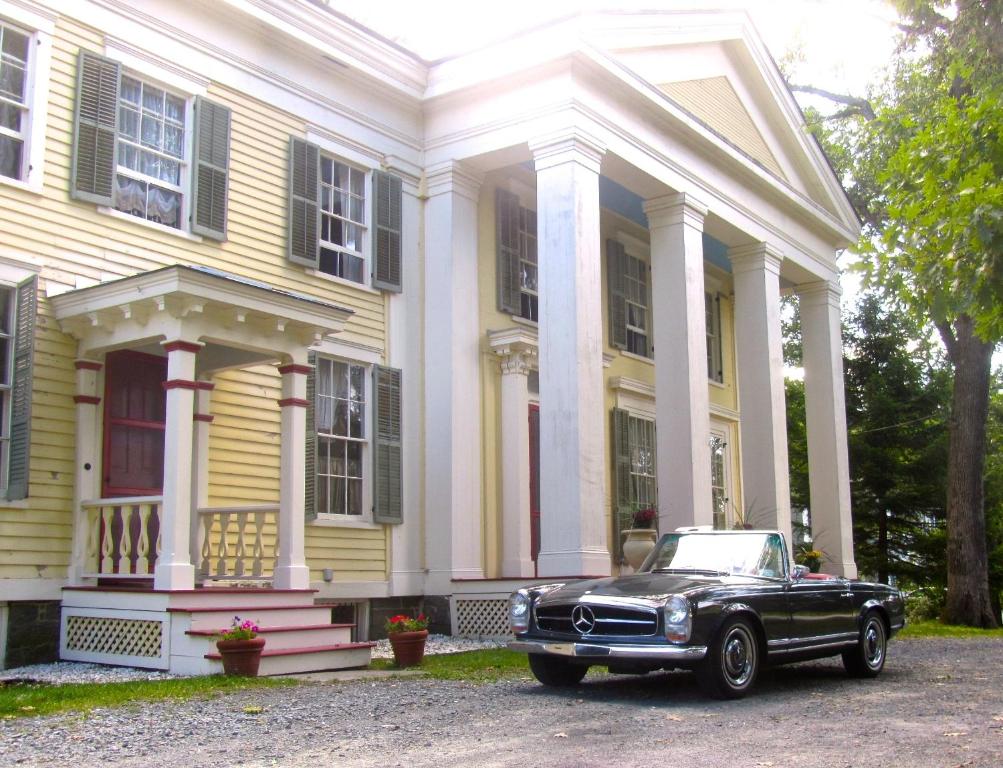
Destination Distinctive Accommodations
Oak Cliff Bed and Breakfast, 78 Church Hill Road, Waterford, NY 12188, 518-281-4434
Accommodations here let you stay in a completely restored property, with a fascinating story, built in 1830. Duncan McMartin, Jr. was a New York Assemblyman and founder of the Adirondack Iron Works. His son-in-law, Truman Giles Younglove, a civil engineer, married Elizabeth McMartin in 1841, and Jane McMartin in 1850. He headed the water power company, supervised the construction of Mill #3 at Harmony Mills, incorporated the Cohoes Savings Institution and was a director of the First National Bank of Cohoes. His son Truman Giles Younglove, Jr. was accused of embezzlement while serving as the treasurer of the Cohoes Straw Board Company and fled to Illinois. It is rumored that he speculated in stocks and losses of over $80,000 led to his ruin.
DAY THREE
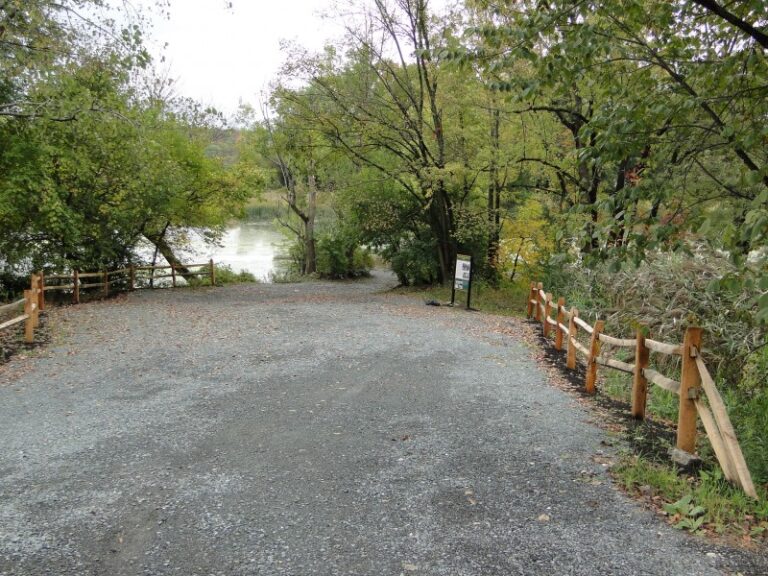
Dunsbach Ferry Site
In the days before bridges, ferries were used to cross the Mohawk. These ferries were located where Native Americans had established trails to the early fording places. The ferry was established by Cornelius Claes in the 1600s. Henry Knox’s cannonade crossed here in 1776 carrying 59 cannons captured from Fort Ticonderoga. For two years near 1900, the ferry was replaced with a toll bridge. The bridge was dramatically destroyed by ice, and ferry service began again!
Vischer Ferry Nature and Historic Preserve
More than 700 acres of wetlands and floodplain form a linear greenway that includes two Erie Canal towpath trails, remnants from the original Erie Canal, remnants of Fort’s Ferry, the first settlement in Clifton Park, Historic Double Lock 19, Clute’s Dry Dock, and an abundance of nature trails. The site is also a Bird Conservation Area recognized by Audubon New York.
Clute's Dry Dock
Clute’s Dry Dock served as a boat building and repair station with three cradles that could each support a canal boat. They also owned a home and store surrounded by several other stores, a school, ice house, barns, and homes of other workers. It was abandoned around 1900 and literally vanished when the area was flooded by the damming of the Mohawk River in 1907.
Whipple Truss Bridge
The Cast Iron Truss Bridge at the entrance to the Vischer Ferry Nature Preserve was designed by Union College graduate Squire Whipple. It became the standard design for the Erie Canal crossings. Standing in the middle of the bridge you can see the 1842 Erie Canal, and a section of the original 1825 Erie Canal.
Lock 19
Remnants of Lock 19 lie between the Whipple Bridge and the end of Ferry Drive. It is a 0.8 mile hike into the site from Ferry Drive.
Vischer Ferry Historic District
The Nicholas Vischer family settled here soon after 1734, building what is now the oldest house in Clifton Park. Son Eldert started a ferry service in 1790 and operated a gristmill across Stony Creek. The church, constructed in 1802, was soon followed by the Greek Revival homes along Riverview Road. When river traffic dwindled, the town became a summer resort.
Vischer Ferry General Store
Gerardus Clute purchased the property and for a time operated the store as the post office. The original 1787 store was discovered during renovations when large field stones flanking the basement entrance were unearthed. Today, it is back in business as the local store.
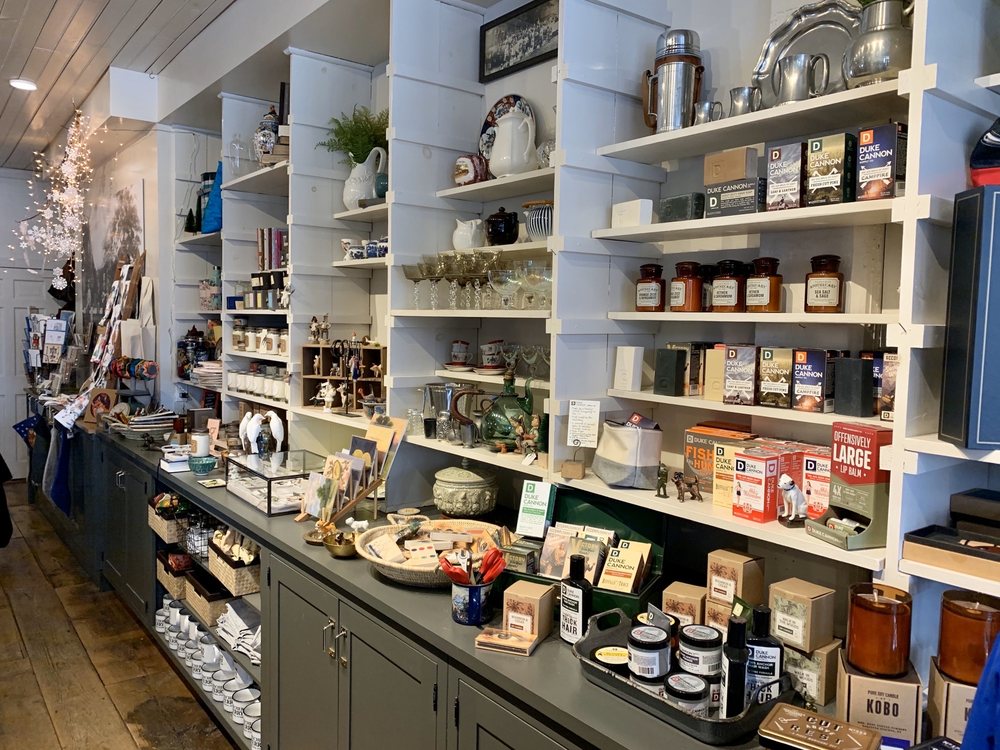
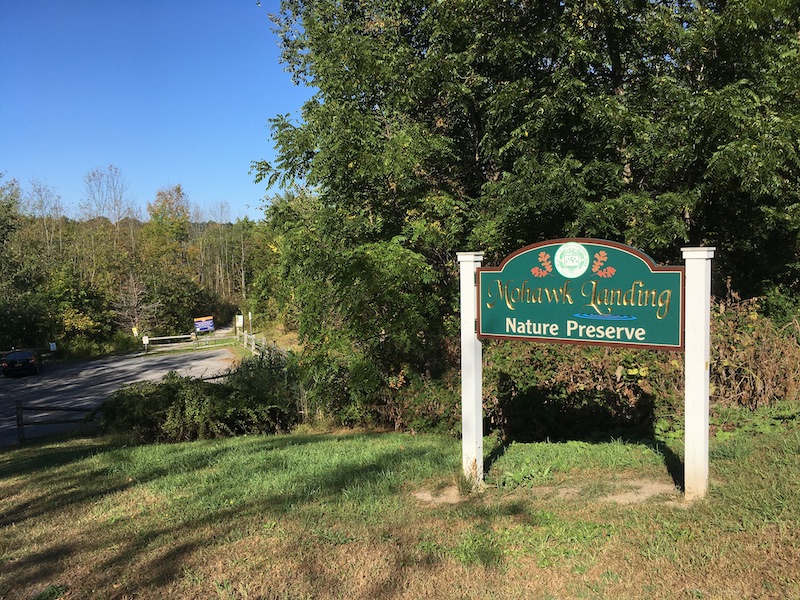
Mohawk Landing Nature Preserve
Located on Riverview Road just down the slope of the Orchards, the walk to the river here is easy on a short boardwalk through the woods which lead to a beautiful overlook. Bring a picnic and enjoy it at one of the tables near the river.
Riverview Orchards
Originally settled by the Dutch, this farm on the Mohawk River served a stabling point for horses and mules pulling canal boats, as well as a farm where they were raised, before the Leversee family planted apple trees around the turn of the century. Enjoy the trees in full bloom in May. During harvest season, enjoy fresh apple cider, cider donuts, fruit pies and other locally prepared delicacies. Enjoy great views of the Mohawk River and the Erie Canal from the orchards if you decide to pick your own.
660 Riverview Road, Rexford, NY 12148, 518-371-2174 Daily 9AM-5PM
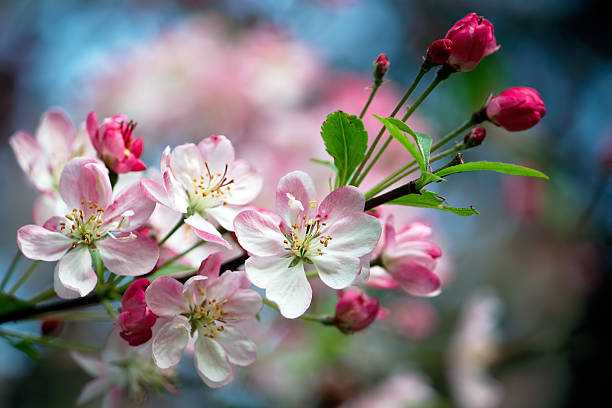
Aqueduct Park
This park, across the river from the bustling canal community of Rexford, encompasses the other end of the upper aqueduct. A general store, now the headquarters for the Schenectady Yacht Club, stood alongside Lock 22. Another lock, 21, was located at the foot of the escarpment on the north side of the river as the canal turned further east. A century ago there was a large hotel on either end of the Aqueduct, used primarily by families from Schenectady who had increasing time for leisure.
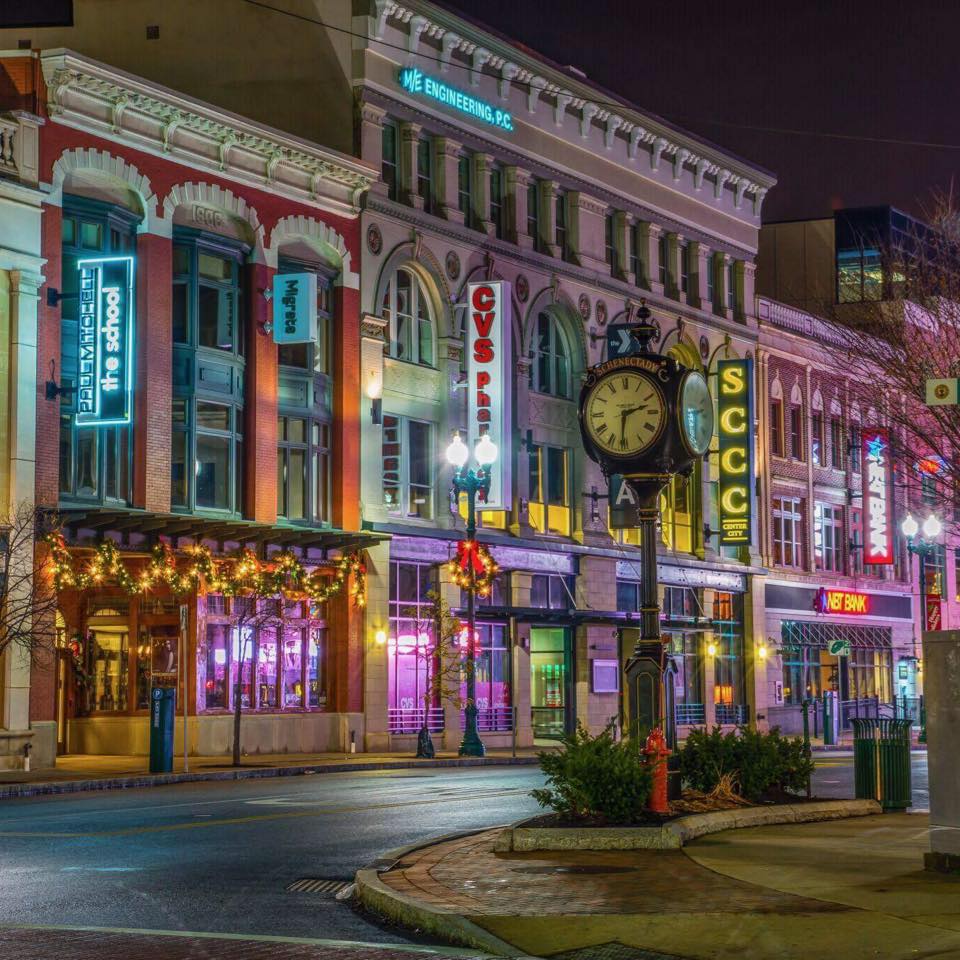
Schenectady
Schenectady was founded in 1661 at a place the Mohawk called “Schau-naugh-ta da”, meaning “over the pine plains.” The original settlement of 12 Dutch homes on present Ferry, Front, State Streets and Washington Avenue was almost wiped out in 1690 during King William’s War, the first of a series of conflicts known as the French and Indian Wars. By 1692, the reconstructed community had English, Scot and Dutch residents and was surrounded by a stockade. The Erie Canal was constructed on the outskirts of town in 1825, on what is now Erie Boulevard.
Destination Distinctive Accommodations
Glen Sanders Mansion, One Glen Avenue, Scotia, NY 12302, 518-374-7262 Originally built right on the Mohawk River in 1658 for Alexander Lindsay Glen, a factor for the Dutch West India Company, parts of the old house were used by son Johannes to build a new home in 1713, farther away from the river and its floods. That home is the core of today’s Glen Sanders Mansion. It changed from the Glen Mansion to Glen Sanders when Debra Glen married John Sanders in 1739. It stayed in the family until 1961, when it was transformed into an inn. Important guests over the years included George Washington and Louis Philippe of France.
Destination Distinctive Dining
Perreca’s Bakery, Catering, & MORE 31 N Jay St, Schenectady, NY 12305, 518-377-9800 Relaxed Italian restaurant featuring pizza and pasta along with seafood dishes and desserts. Located in the heart of Schenectady’s vibrant Little Italy district.
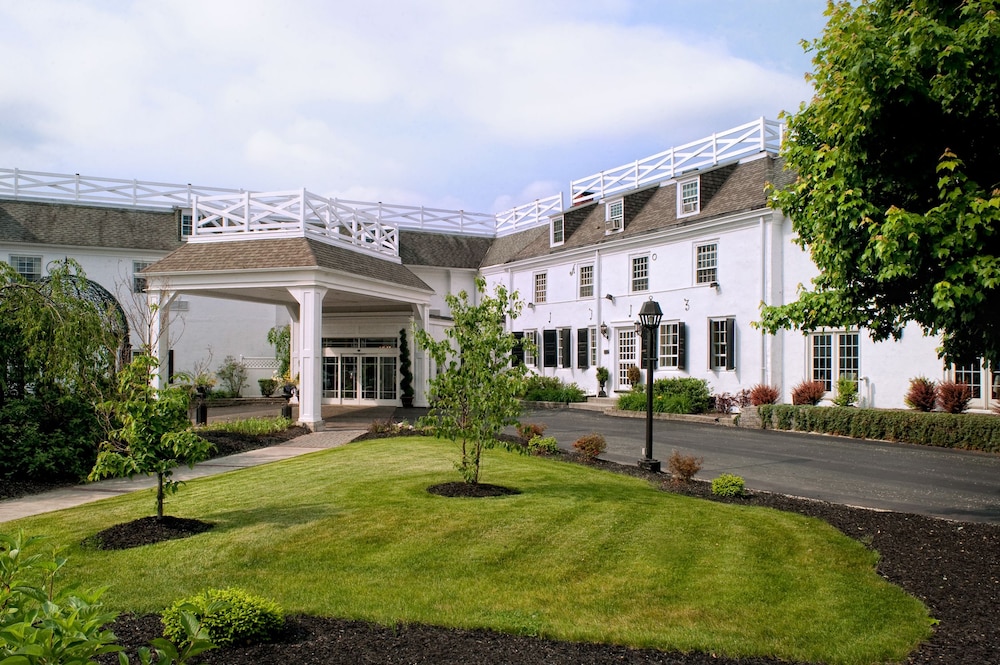
DAY FOUR
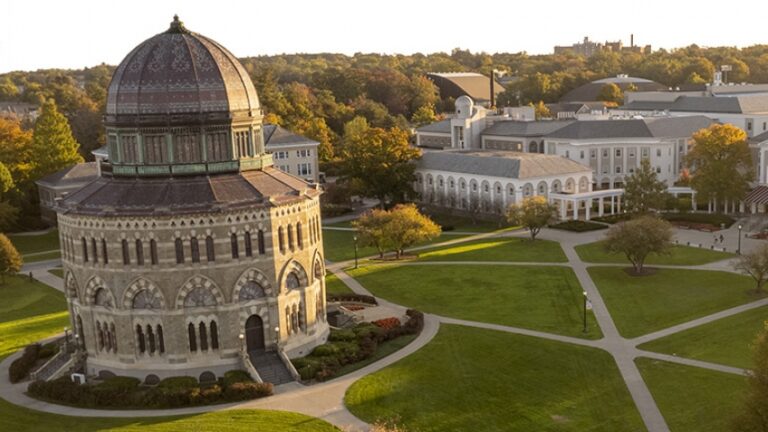
Union College
The first college chartered by the New York State Board of Regents and the second in New York State, sits on 130 beautifully landscaped acres developed with a master plan created in 1813 that became a model for later campuses. A great central court, flanked on three sides by buildings, is open to the west. The Nott Memorial now stands at the center of the grounds, on the spot originally designated for the pantheon. Former housing surrounding the college has been meticulously restored as campus offices and classrooms.
Stockade Historic District
This unique neighborhood is home to more than 40 pre-Revolutionary houses in architectural styles that include Dutch Colonial, Georgian, and Federal. It was New York’s first local historic district recognized 300 years after its founding, described by the National Park Service as “the highest concentration of historic period homes in the country.” A walking tour of the district is offered by the Schenectady Historical Society.
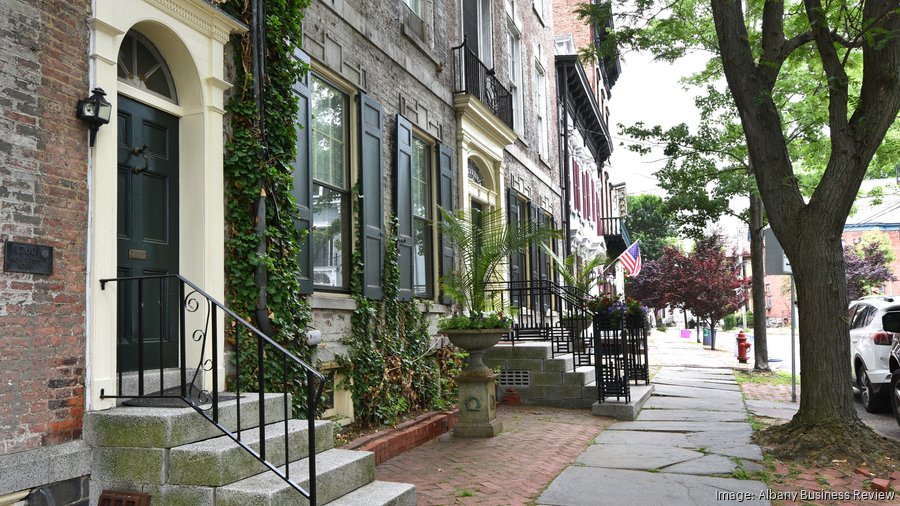
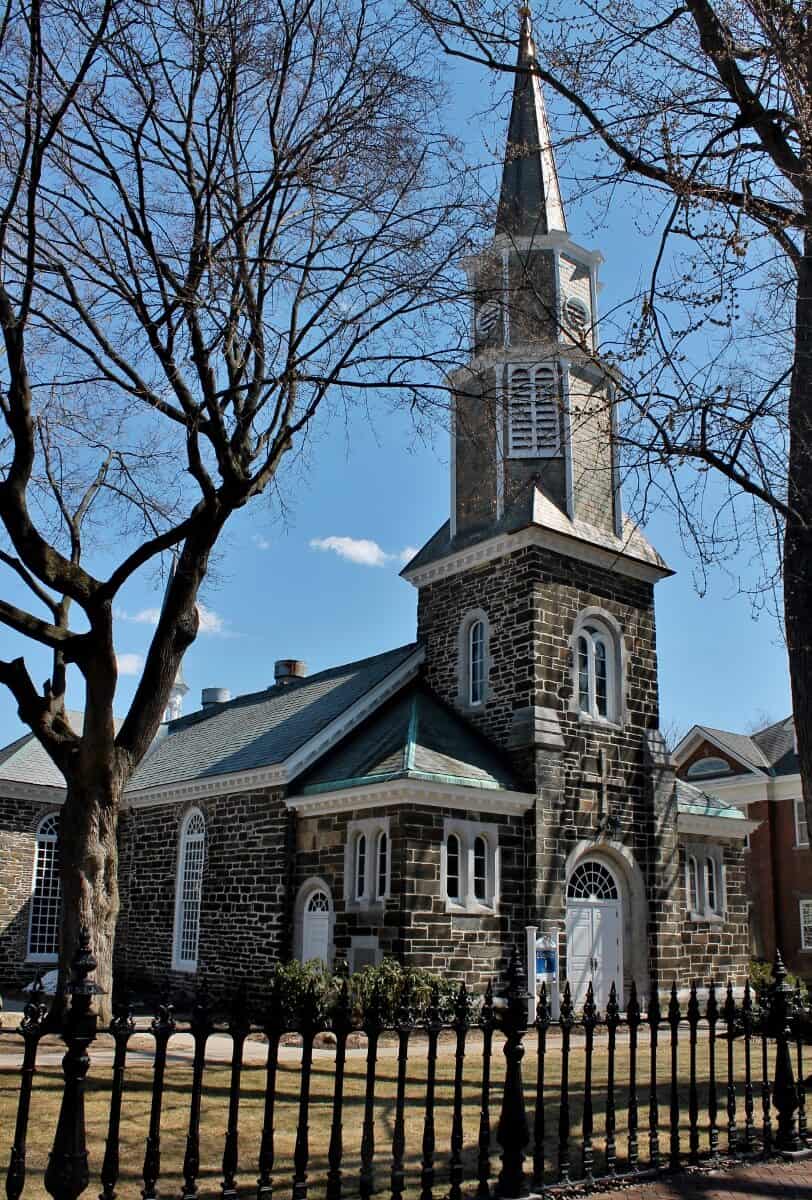
St. George's Episcopal Church
Saint George’s began as an Anglican Parish in 1735. By 1758, Sir William Johnson, His Majesty’s Superintendent for Indian Affairs in North America gave a generous pledge and solicited contributions from friends and fellow officers which, together with a generous gift from Trinity Church New York, was enough to build the church.
30 West Ferry Street, Schenectady, NY 12305
Schenectady Historical Society
Nestled in the heart of Schenectady’s Stockade Historic District, the Schenectady History Museum and the Grems-Doolittle Library illustrates the history of Schenectady County through interactive exhibits. The museum also houses the Schenectady Heritage Area Visitors Center.
32 Washington Street, Schenectady, NY 12305, 518-374-0263, M-F 9AM-5PM, Sat 10AM-2PM
The Brouwer House
The 1730 Brouwer House, Schenectady’s oldest home filled with authentic character, is the only colonial-era Schenectady house open to the public.
14 North Church Street, Schenectady, NY 12305, hours by appointment.
Scotia
Alexander Lindsey Glen named Scotia in honor of his native Scotland. The Scotia Library is located in a residence built for his grandson Abraham in 1730. In the early years, farms growing corn to make brooms stretched along the Mohawk River almost to Amsterdam. By the late 1800s, the broom industry had moved to the Midwest and heavier industry came to Schenectady. Trolleys across the river enabled workers to transform the town into a residential area.
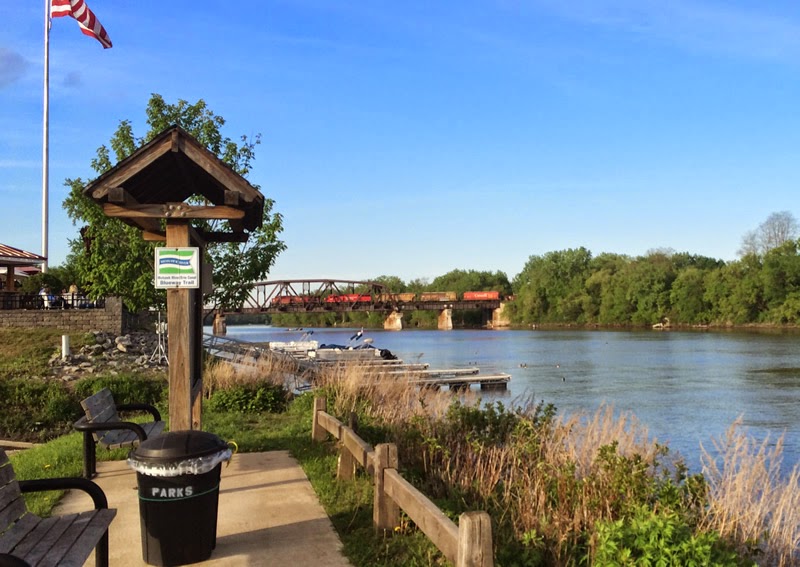
Mabee Farm Historic Site
Before departing the area, consider visiting Mabee Farm, the oldest farm in the Mohawk Valley, dating from 1705. As you walk across the weathered pine floors, try to imagine what life was like over 300 years ago. Admire the hand-pegged Dutch barn built in the 1760s, meander through orchards, gardens, and forest trails, and tour a reproduction 18th century bateau tied up on the river to understand how goods were shipped on the frontier.
1100 Main Street, Rotterdam Junction, NY 12150, 518-374-0263 Tu-Sat 11AM-3PM, Adults $10.
Contact Information
National Travel Center
433 North Charlotte Street
Lancaster, PA 17603